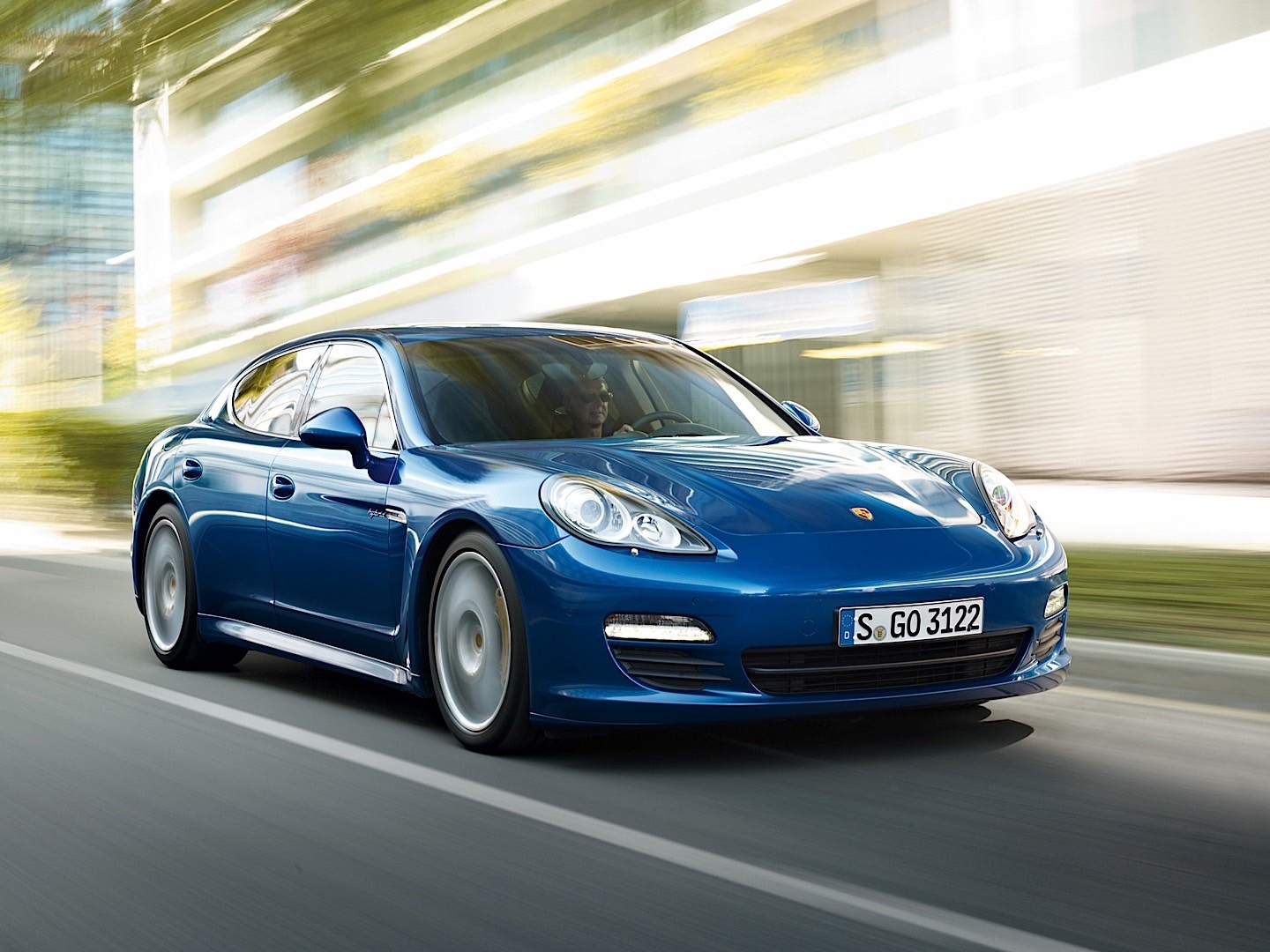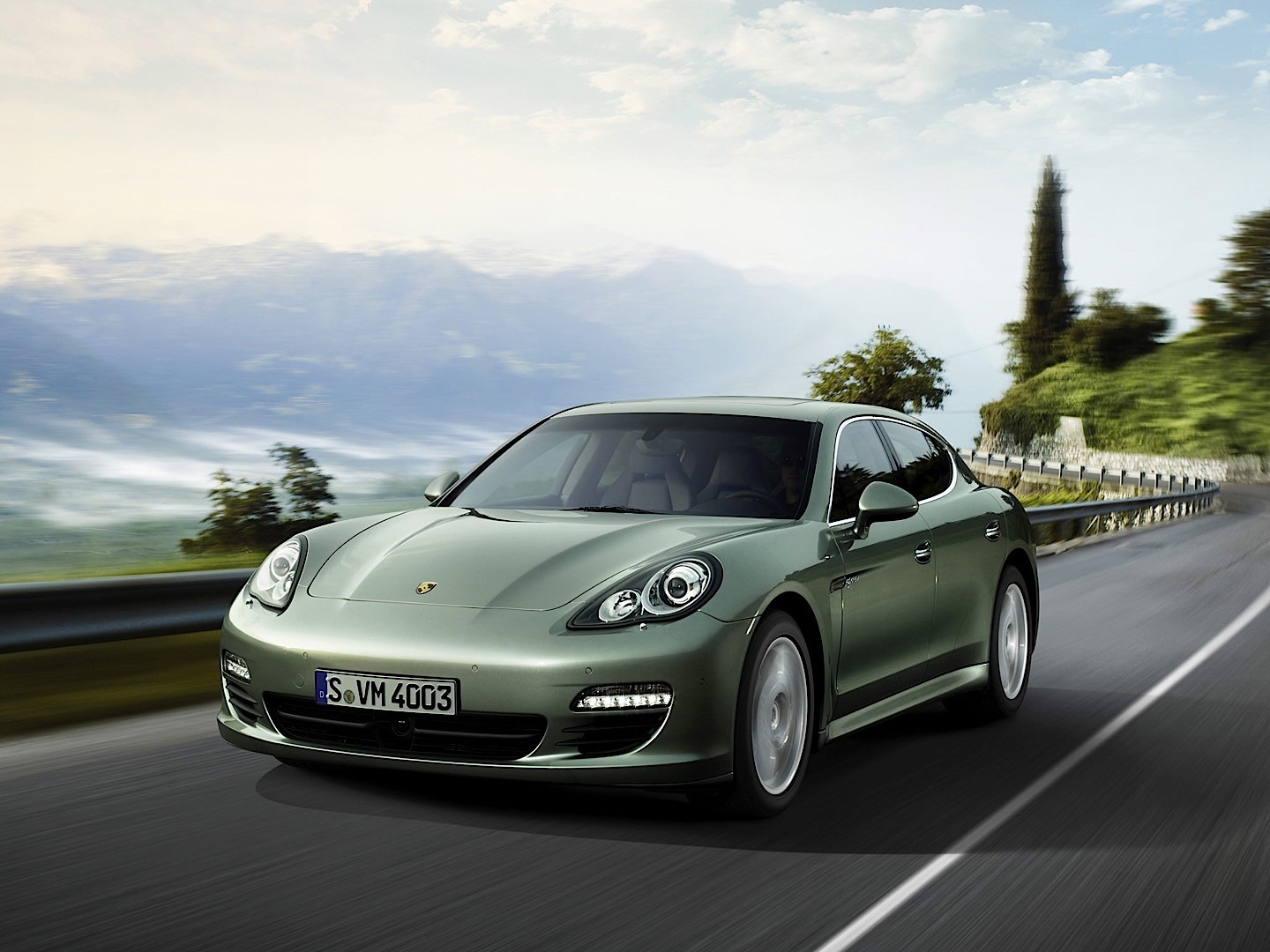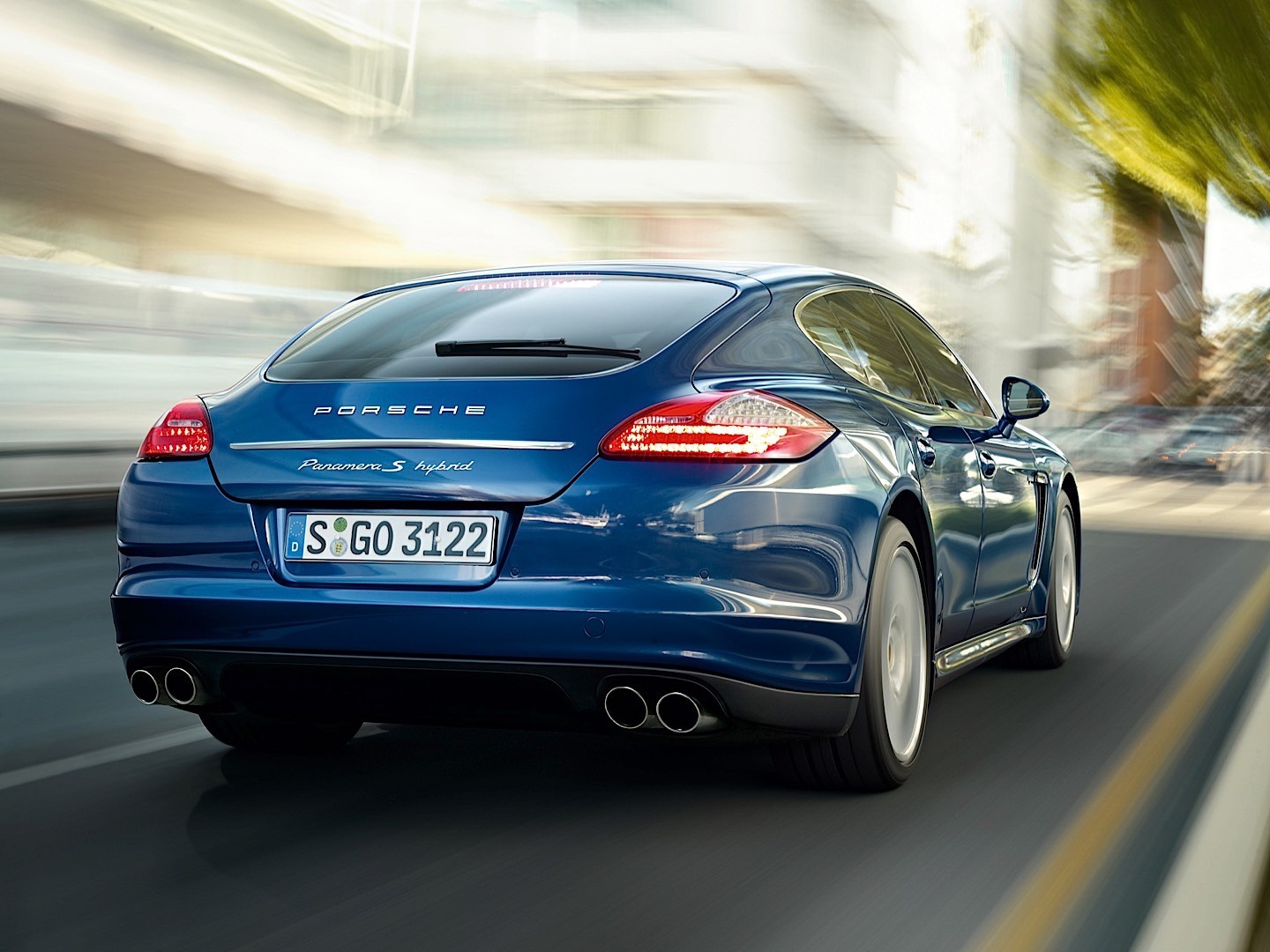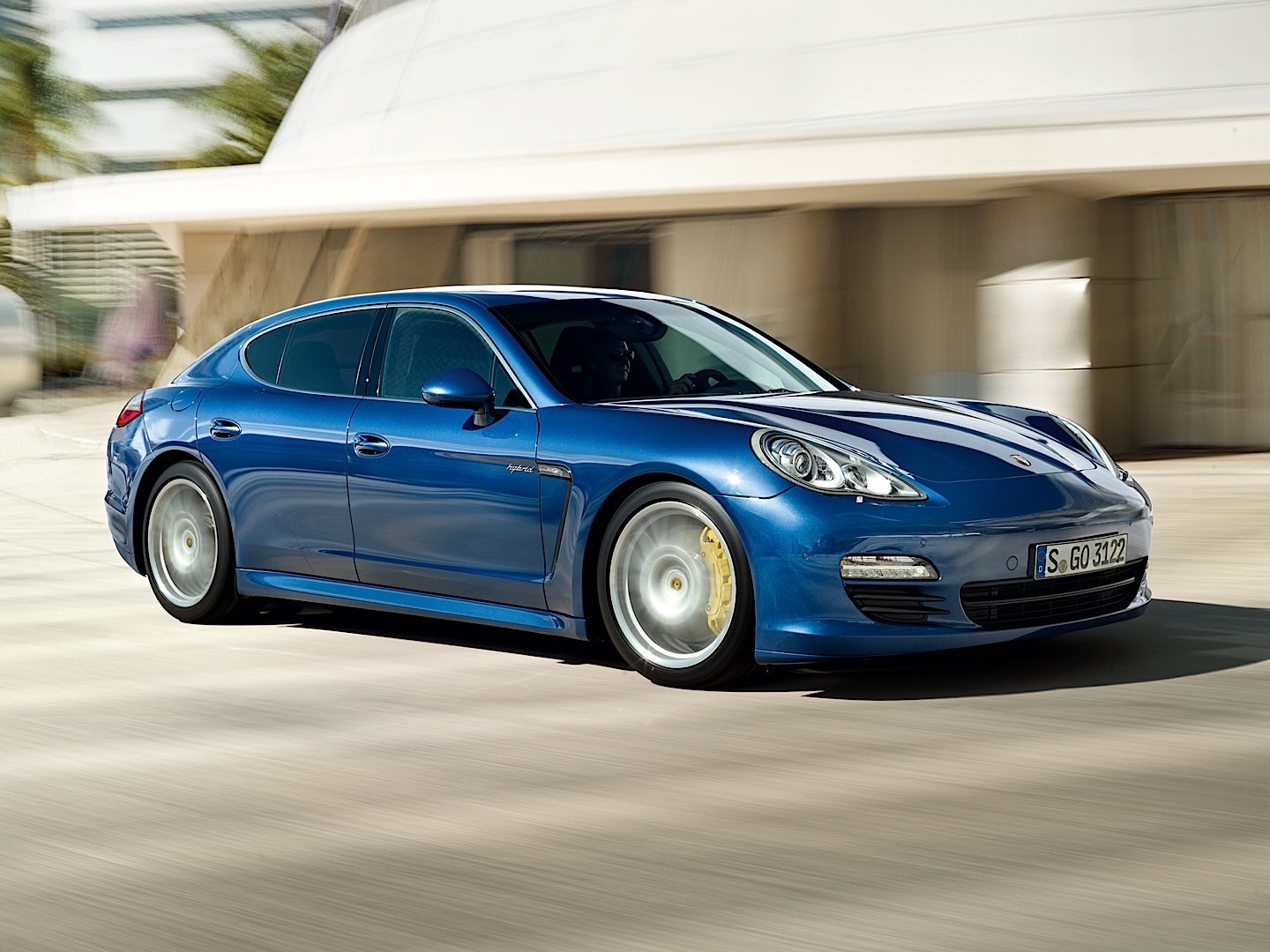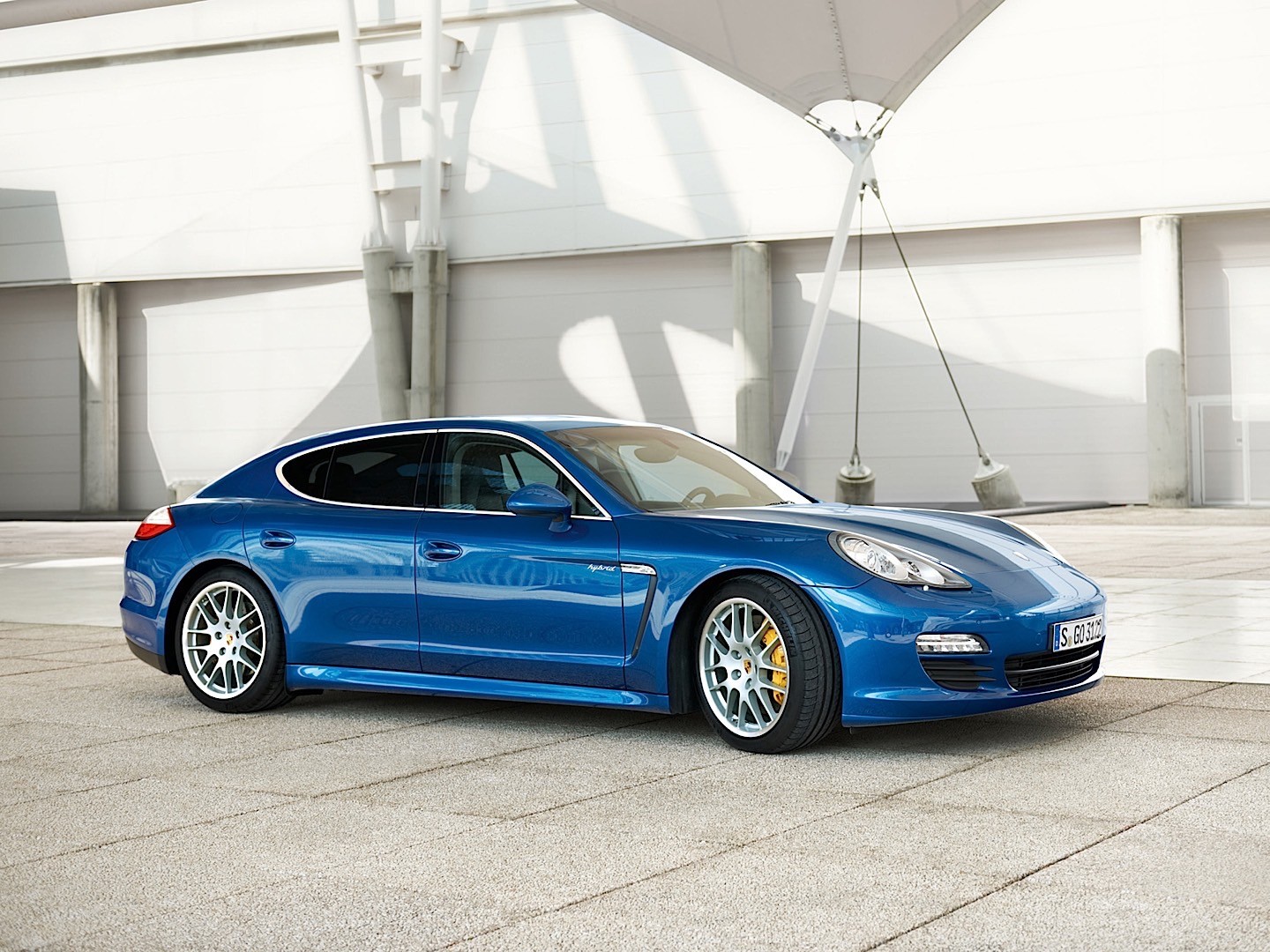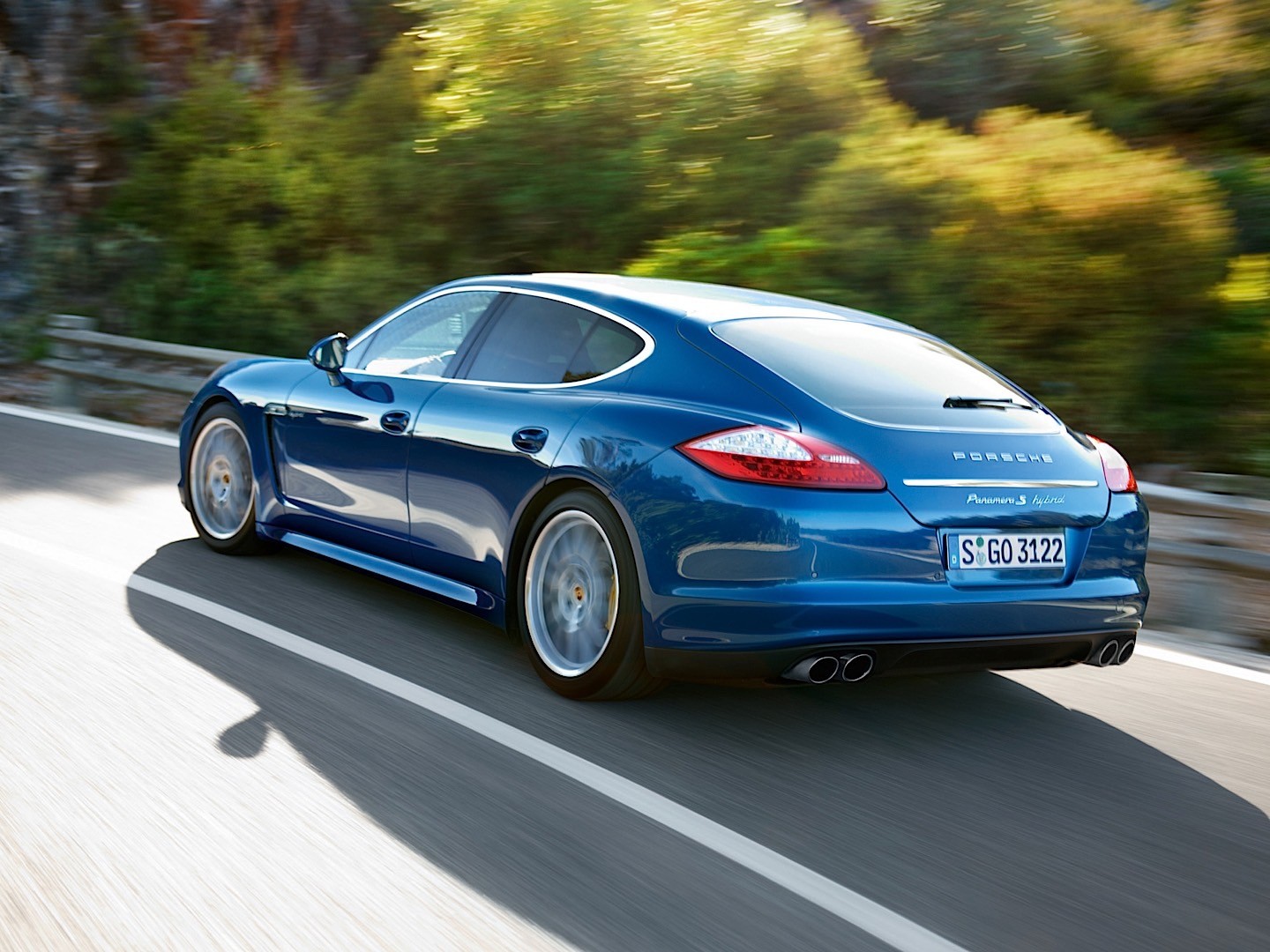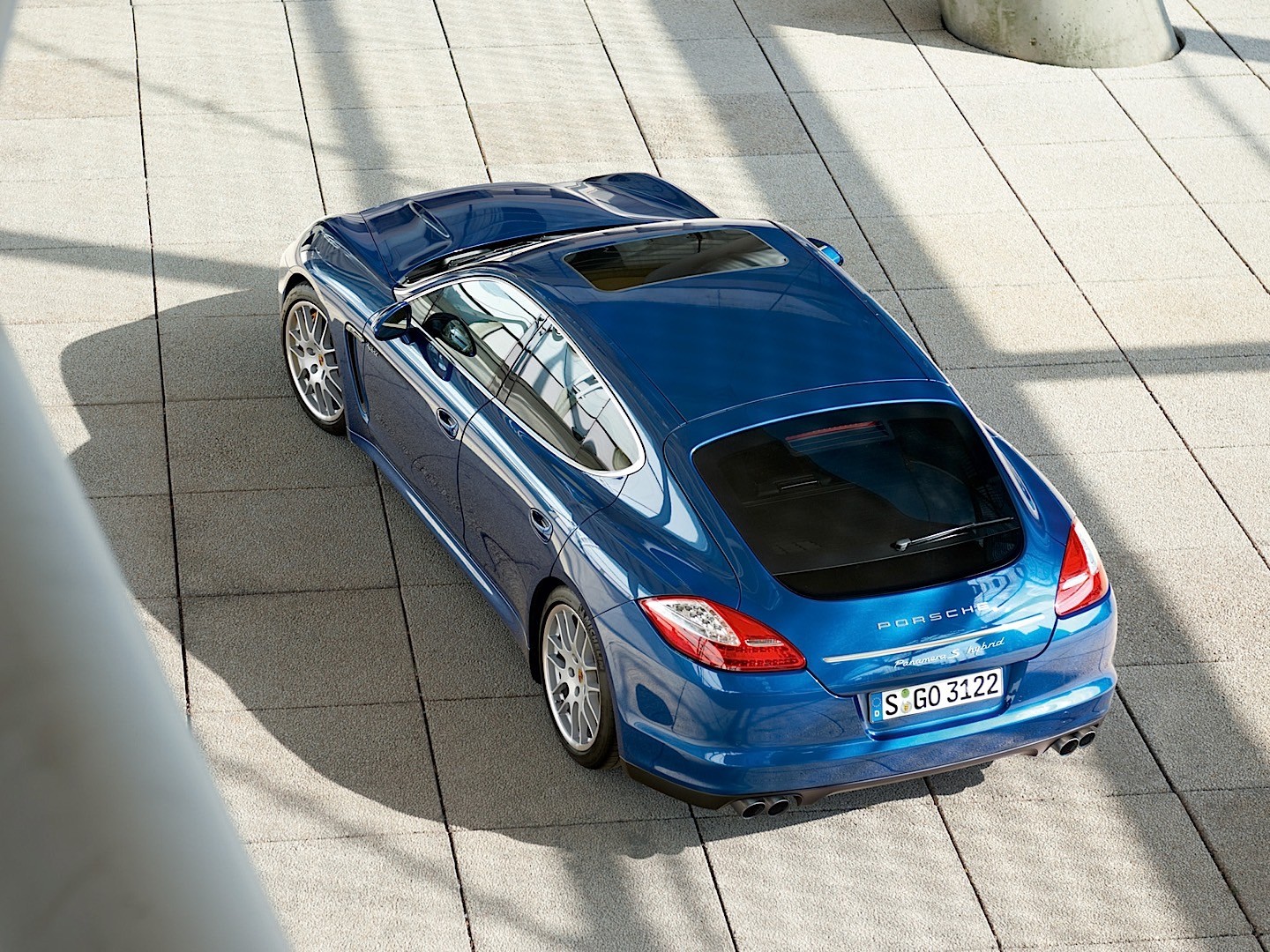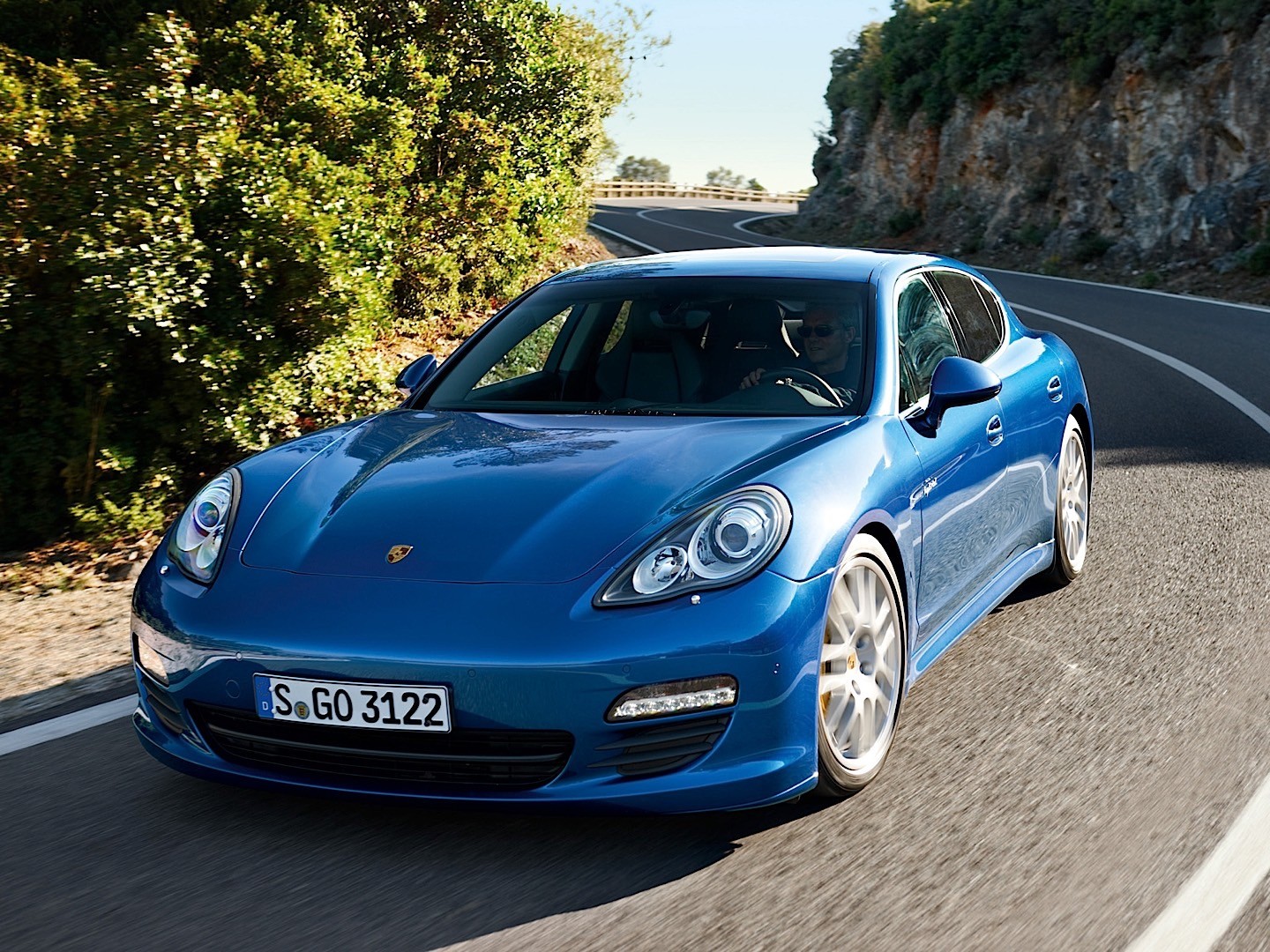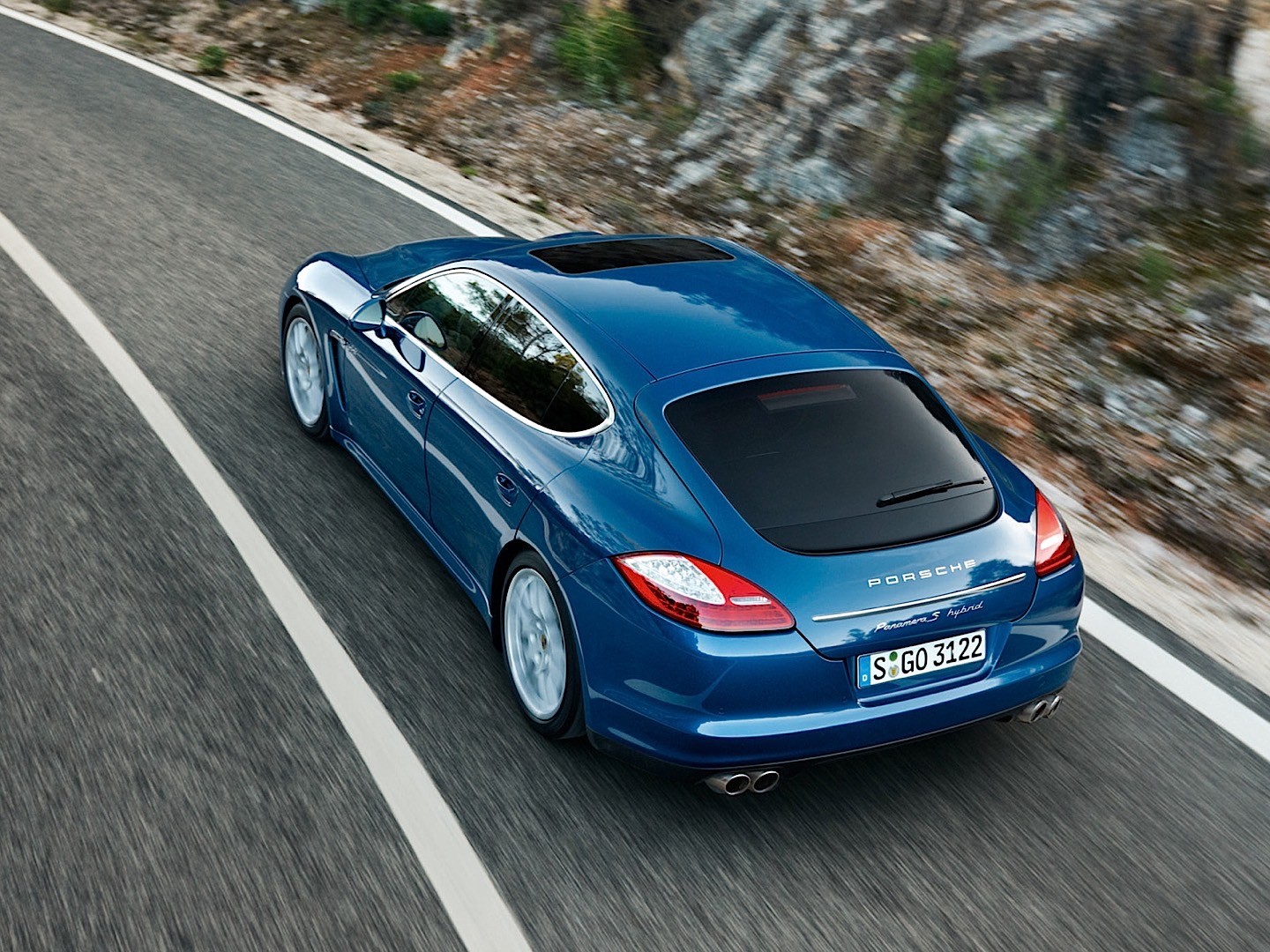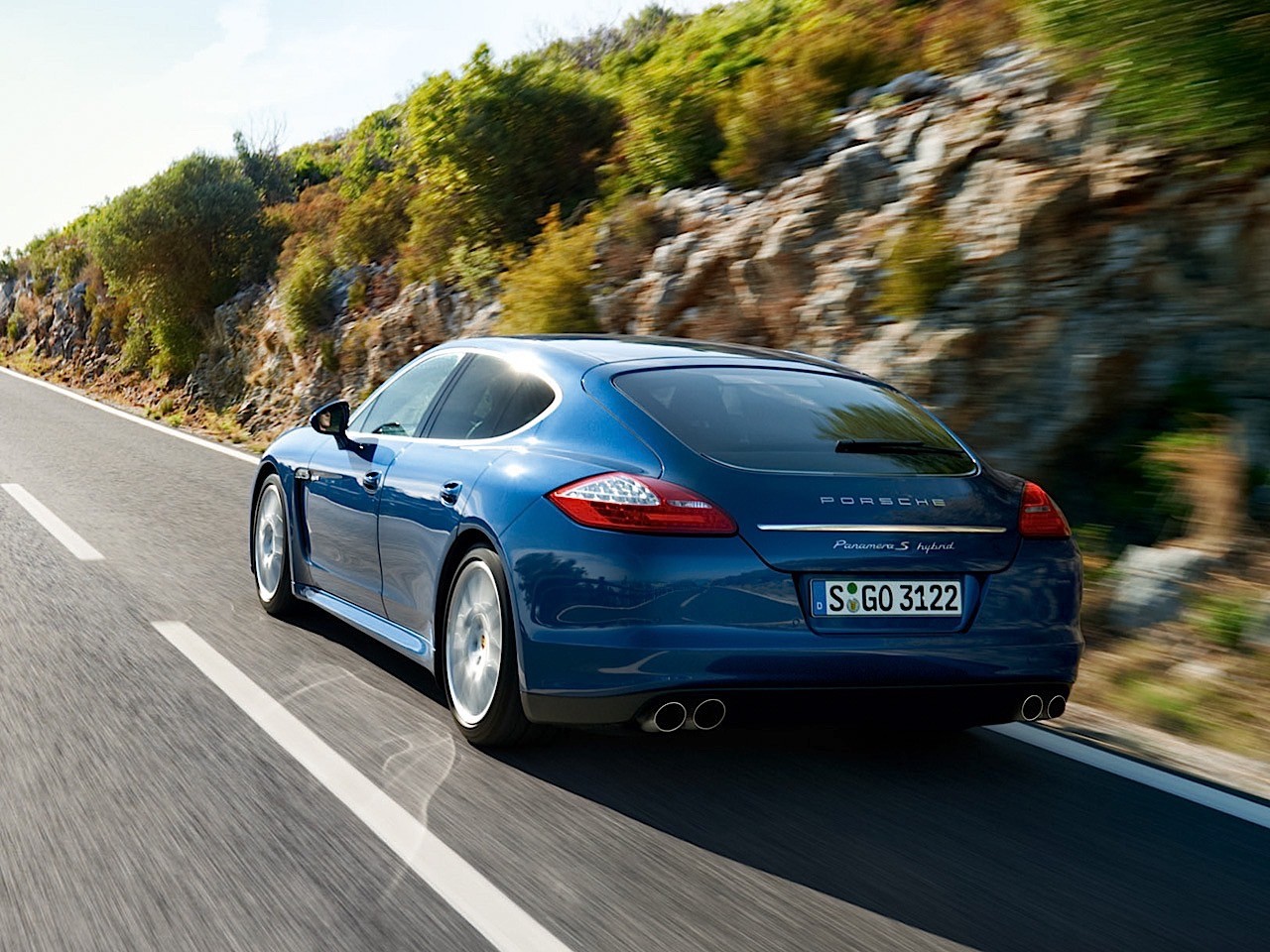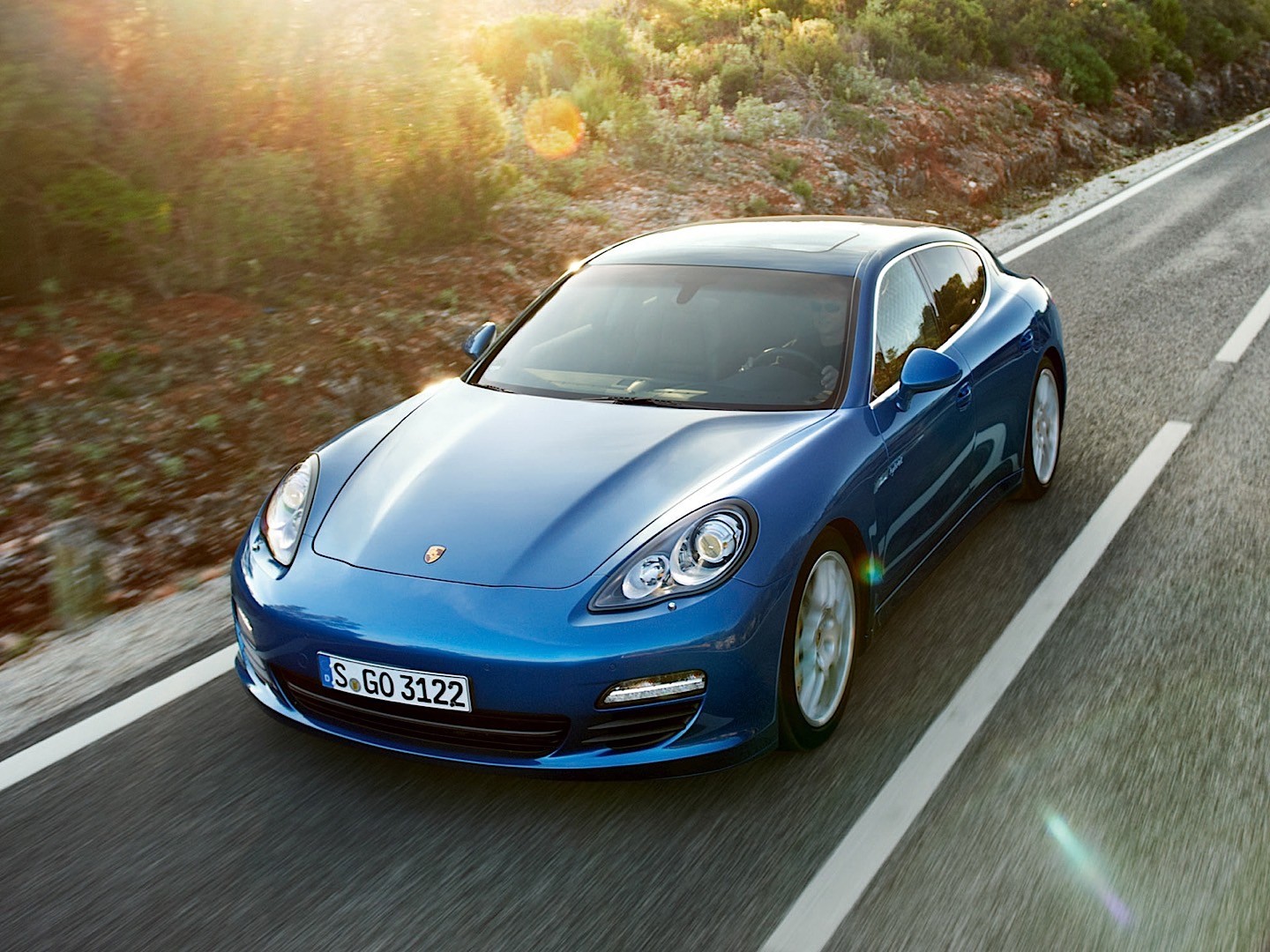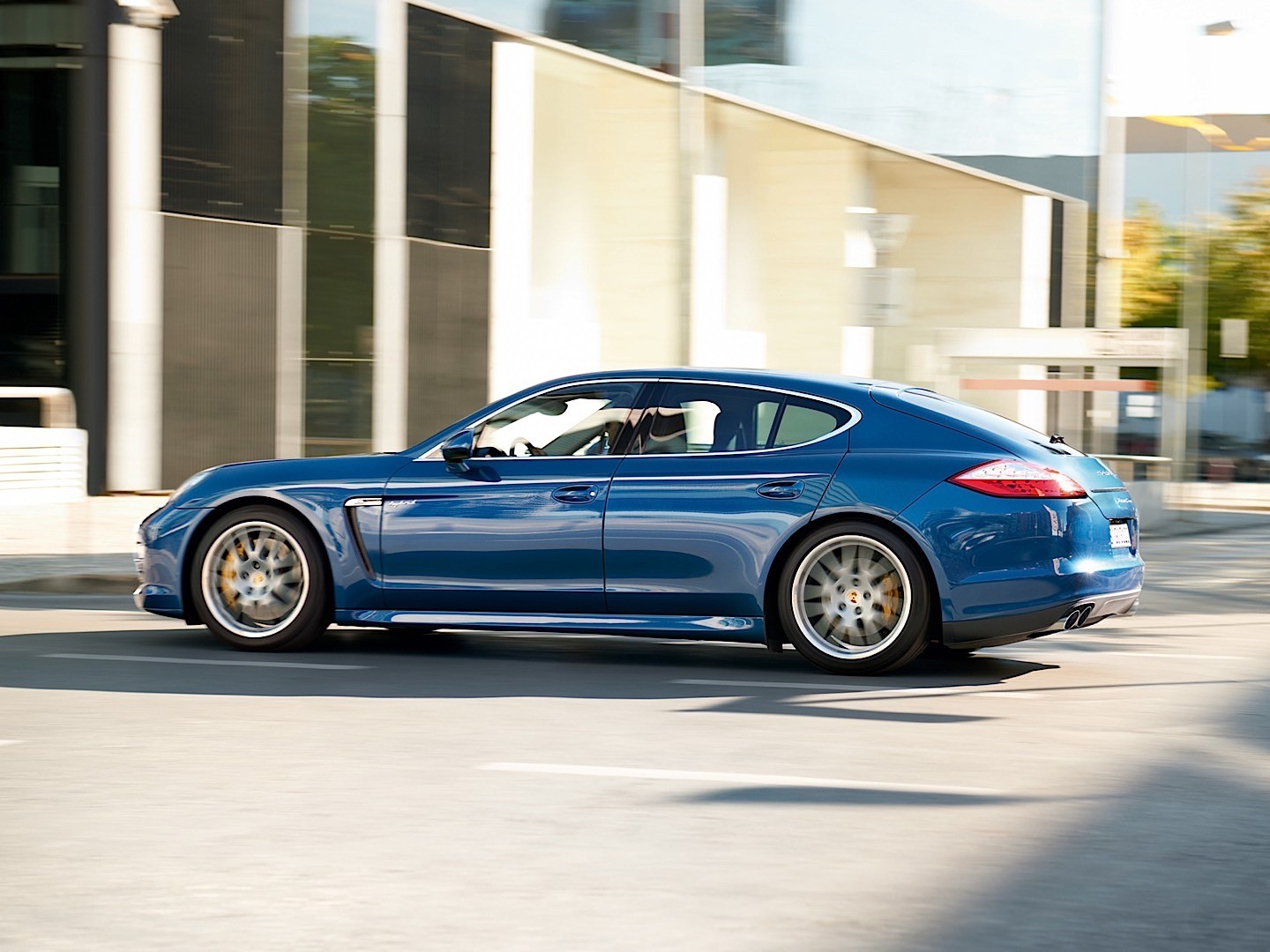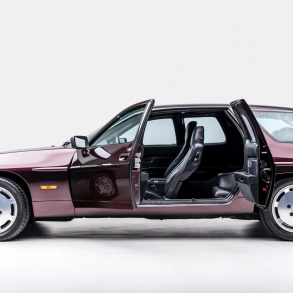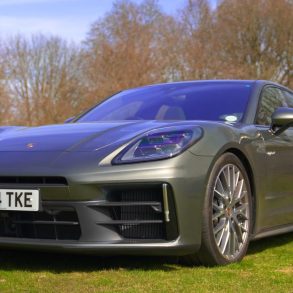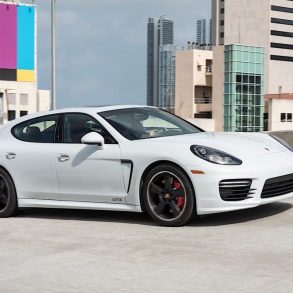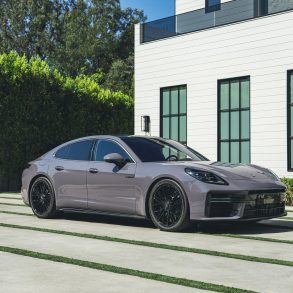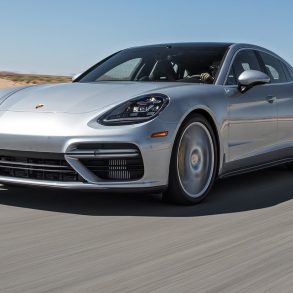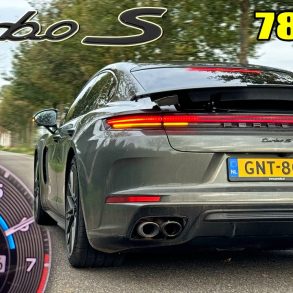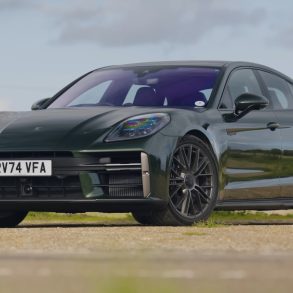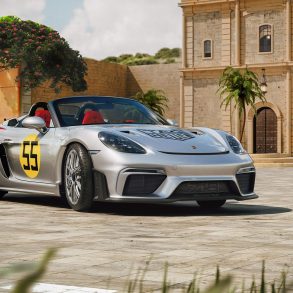(2011 – 2013) Porsche Panamera S Hybrid – Ultimate Guide
Porsche decided to offer a hybrid version for its four-door GranTurismo range. It already had the system developed for the Cayenne range. It was just a matter of time to install it in the Panamera. The Hybrid version of the Panamera was unveiled in downtown Kuala Lumpur in 2011. Since its launch, the four-door GranTurismo Porsche was very well received by the market in all its forms. The Hybrid version was launched at the same time with the Turbo S version.
The Panamera Hybrid’s was based mainly on the Panamera S version. The profile resembled an elongated 911 or the 989 concept-car. On the front fenders, two vents were used to extract the air within the wheel-well and decrease the front-lift effect. In the back, the taillights resembled those found in the Cayman. In the back, on the trunk-lid, a retractable wing was installed. It was automatically extended at speeds over 120 kph (74.5 mph). The green brake calipers were one of it’s particularities, apart from the Panamera Hybrid badge in the back.
Inside, the Panamera Hybrid designers took their inspiration from the Vertu luxury mobile phones. A four-seat layout was the only option, with a big center console that separated the driver from the other passengers. In the back, there was a decent room for adults and since it was a hatchback it could get an impressive amount of luggage. The dashboard was typical for a Porsche, with round dials and centrally-mounted tachometer. Despite its hatchback shape, the rear passengers had enough legroom and headroom.
The powerplant consisted of a 3.0-liter V6 supercharged gasoline unit and an electric motor. The internal combustion unit offered 333 hp while the electric motor did the rest of the 47 hp. The whole system was mated to an 8-speed automatic gearbox.
Pictures
Press Release
The Porsche Panamera S Hybrid marks the beginning of a new chapter of Porsche Intelligent Performance, continuing the success story of the four-door Gran Turismo. Not only is the new model the most economical Porsche of all time, it also outperforms by a mile all full hybrid production cars of its class, the luxury class, in terms of consumption and CO2 emissions. And at the same time, without any restrictions, it offers the sporty, exclusive character and custom comfort so typical of this unique Porsche Gran Turismo family.
The Porsche Panamera S Hybrid is the first parallel full hybrid car in the luxury class with unique features. The range on electricity alone is approximately two kilometres (1.24 miles), the speed in electric mode is up to 85 km/h (53 mph) depending on the driving situation. Moreover, thanks to the so-called “sailing” mode on motorways and main roads, the Porsche hybrid is the only system in the world able to exploit additional consumption reserves in higher speed ranges. This entails disengaging and switching off the internal combustion engine at speeds of up to 165 km/h (103 mph) during phases when no power is delivered by the internal combustion engine.
The exterior of Porsche’s new Gran Turismo series model corresponds extensively to the Panamera S. Distinguishing features include the “Panamera S hybrid” emblem on the rear and the “hybrid” badges on both front doors.
The equipment for the Porsche Panamera S Hybrid is on a par with the very high standards of the Panamera S with the eight-cylinder engine. In addition, the hybrid model is fitted with the adaptive air suspension including the adaptive damping control system PASM, Servotronic and a rear wiper all as standard. Furthermore, the new Gran Turismo has an innovative display concept which provides all of the car’s relevant information about the hybrid-specific driving conditions to the driver.
The drive concept of the Porsche Panamera S Hybrid therefore parallels that in the Cayenne S Hybrid already proving its worth there. Continued development and adapting to the potential of the Porsche Gran Turismo bestowed improved and additional functions upon the Panamera. Limit speeds for purely electric driving and sailing are higher, extended driving in electric mode is possible, and active cooling of the battery raises the hybrid system’s availability.
At present, significantly lower emissions will result in tax advantages for the Panamera S Hybrid in many markets. In comparison with the Panamera S, the motor vehicle tax in Germany will be lower by 204 euro annually. In France, the hybrid model will save the owner a one-time sum of 1,850 euro, in Spain 4,475 euro, and in the Netherlands 8,584 euro. In markets outside Europe, up to 2,200 US dollar can be saved in the US, Japan exempts the buyer from paying the equivalent of 4,000 euro, and in China this advantage adds up to the equivalent of about 15,000 euro.
A powerful team: 333 hp V6 compressor engine and 34 kW electric motor
The Porsche Panamera S Hybrid is driven by the same engine combination that has already proved itself in the Cayenne S Hybrid: The main power comes from a three-litre V6 compressor engine which delivers 333 hp (245 kW) and is supported by a 34 kW (47 hp) electric motor. Their maximum torque of up to 300 Nm is available constantly at speeds below 1,150 rpm. The electric motor can propel the Panamera S Hybrid all by itself or can support the internal combustion engine. And it can be used as a generator or as a starter.
The electric motor is hooked up to a nickel-metal hydride battery (NiMH) which is used to store electrical energy generated while braking or driving. The battery fitted under the floor of the luggage compartment has a capacity of 1.7 kWh supplying a voltage of 288 volts. It goes without saying that the Porsche Panamera S Hybrid has an auto start/stop function which automatically shuts down the internal combustion engine even when the car is not moving.
Smooth power transmission: eight-speed Tiptronic S
For the first time in a Panamera, power transmission is handled by the standard eight-speed Tiptronic S with wide ratio spread familiar from the Cayenne models. The Panamera S Hybrid is exclusively available with rear-wheel drive.
The eight-speed Tiptronic S for the Porsche Panamera S Hybrid is a transmission characterised by high efficiency and fast gear changes coupled with supreme gearshift and ride comfort. Its design is such that revs are reduced by about 20 per cent in seventh and eighth gear, which decidedly contributes to lowering fuel consumption especially during long stretches on motorways. Top speed is reached in sixth gear.
The fast gear changes which the driver hardly notices guarantee highest agility and maximum driving pleasure. Thanks to intelligent gearshift programmes, the driver can use the accelerator and brake pedals to influence deliberately the gear change behaviour of the Tiptronic S. Rapid accelerator pedal action makes changing gears more dynamic – entirely without kickdown. So, if you lift your foot off the accelerator pedal quickly just before you enter a bend, upchange is suppressed. In addition, the gear engaged is blocked preventing mid-corner upchanges.
The gear change characteristics of the Porsche Panamera S Hybrid transmission have been adapted to the extended hybrid drive operating conditions. This is necessary for improved recuperation performance, for instance adjusting gear change speeds (downchanges) during brake energy recovery, or for a comfortable restart of the internal combustion energy after driving in purely electric mode. The special settings of the eight-speed Tiptronic S make available optimum gear change strategies also when drawing additional power from the electric motor under acceleration.
Powerful, compact, and lightweight parallel full hybrid
Porsche uses a parallel full hybrid instead of the power-split hybrid drive. A concept for which there are several good reasons. In contrast to other hybrid concepts displaying their advantage particularly during urban driving, the Porsche-developed system allows the Porsche Panamera S Hybrid to sail at speeds of up to 165 km/h (103 mph) without engaging the internal combustion engine or the electric motor. The parallel full hybrid also enables the acceleration and elasticity typical of a Porsche without the so-called rubber band effect of power-split hybrid systems. The concept therefore perfectly matches Porsche’s philosophy of offering extraordinary performance and maximum efficiency at the same time.
One additional advantage is the comparatively small space required, because the entire hybrid module is extremely compact with a length of just 147.5 millimetres. It is mounted between the internal combustion engine and the transmission, and essentially consists of the ring-shaped synchronous motor and a decoupler at the side connecting up to the internal combustion engine. Its power distribution and characteristics therefore correspond to those of a conventional drive. The Porsche hybrid also carries relatively little extra weight. With an unladen weight of 1980 kg, the Panamera S Hybrid lies at the lower end of its class and enables a payload of up to 505 kg. Even when driving in purely electric mode, all vehicle functions are maintained which is ensured by electric pumps for power steering, brake booster, automatic transmission oil circuit, air conditioning compressor, and other components.
Driving the Hybrid 1: electric car right from the start
In principle, the Porsche Panamera S Hybrid is easy and uncomplicated to handle like any other Porsche Gran Turismo. Use and cooperation of electric motor and internal combustion engine are controlled automatically. Every driver can nevertheless influence the car’s behaviour at will: either using accelerator and brake pedals or pressing the E-Power button.
When pulling away, the system decides whether the Panamera S Hybrid drives on electricity or uses the internal combustion engine. Provided that oil, cooling water, and battery have a temperature exceeding 15 degrees Celsius, ambient temperature is more than ten degrees, and the battery’s charge level is higher than 38 per cent, and if the accelerator pedal is pressed down gently, the Gran Turismo will set off using only the electric motor. This means that the driver can leave an underground car park in electric mode without engaging the internal combustion engine even though the car was parked there overnight. If heating is necessary or if windows start misting up, the system will start the internal combustion engine after about 30 seconds which will be prolonged to about two minutes after the E-Power button was activated. If there is no need for the internal combustion engine to kick in, the Porsche Panamera S Hybrid can cover short distances without any emissions at speeds of up to 85 km/h (52.8 mph) under favourable driving conditions and with a moderate driving style – like in residential areas. The range in purely electric mode is about two kilometres (1.2 miles) on level ground. Going downhill – like from an Alpine pass – the Panamera S Hybrid can travel distinctly longer stretches on electricity alone because of the intensive battery charging phases while braking.
E-Power button extends range in electric mode
By activating the E-Power button in the centre console, the range which can be covered on electricity alone is extended. An LED on the button indicates activation and the message “E-Power” lights up in blue on the instrument cluster. The availability depends on parameters like charge level and temperature of the battery. In E-Power mode, the accelerator characteristic is modified so that acceleration commands are implemented significantly more moderately, and early automatic starting of the internal combustion engine is prevented when higher power is required. In comparison with the Cayenne S Hybrid, torque reserves in the Panamera for a restart are reduced from 100 Nm to 50 Nm which translates into more power for acceleration in electric mode. In practice, the driver can accelerate with gusto in electric mode without the internal combustion engine kicking in. At speeds higher than 75 km/h (46.6 mph), the E-Power mode is deactivated.
Driving the Hybrid 2: joining forces for acceleration
If the driver steps on the accelerator pedal to demand more power, the internal combustion engine fires. A kickdown for full acceleration triggers the so-called “boost mode” which makes maximum power of the Porsche Panamera S Hybrid available to the driver for a short period of time. In this case, the driving torques of the internal combustion engine and the electric motor are superimposed, i.e. they add up. This is a big advantage of the parallel full hybrid concept. While the internal combustion engine develops its maximum torque of 440 Nm at 3,000 to 5,250 rpm, the electric motor is able to implement its full torque of up to 300 Nm from a standing start. Maximum output of both drives totals 380 hp and is available at 5500 rpm, and the combined torque of 580 Nm available already at 1000 rpm guarantees brawny acceleration.
Since maximum torque of the drive units is available at different speeds, maximum values cannot simply be added up. At higher revs, the drive concept causes the torque of the electric motor to decrease. Continued constant and efficient power at high revs is provided by the internal combustion engine with the electric motor continuing to assist. Both drives therefore complement each other perfectly, enabling the driver to employ powerful, combined output development throughout the entire engine speed range. The Panamera S Hybrid therefore benefits from the two drives’ intelligent interaction thanks to a particularly sporty response from a standing start and high vehicle dynamics also at higher speeds, i.e. when overtaking. Electric boosting is available immediately when using the kickdown function. With the Sport button activated, boost power is increased and both drive units cooperate to deliver maximum power when the accelerator pedal is at 80 per cent of its travel range.
Driving the Hybrid 3: efficient sailing at speeds up to 165 km/h (103 mph)
Thanks to the decoupler, a Porsche full hybrid drive can exploit further consumption potential even at higher speeds offering what is called sailing. If propulsion is not required, the internal combustion engine is automatically switched off and the decoupler disengages the engine from the drivetrain as soon as the driver eases up on the accelerator pedal at speeds up to 165 km/h (103 mph). This eliminates engine braking due to engine drag torque while sailing which reduces driving resistance and in turn fuel consumption. In practice, when driving on motorways, the Porsche Panamera S Hybrid will frequently switch to sailing mode if there is a slight downhill gradient and if the car travels at an even speed, for instance when the automatic cruise control is switched on.
While sailing, the electric motor acts as a generator generating electrical energy without creating any additional loads in the drivetrain. If the car is in sailing mode and the driver presses on the accelerator to overtake, the internal combustion engine is restarted quickly and comfortably within a fraction of a second and the engine speed is increased to match the travelling speed. Even at this pace, a short burst of speed is therefore possible as spontaneously as in a Panamera fitted with a conventional engine.
Driving the Hybrid 4: saving fuel by generating electricity
The unrivalled low fuel consumption of the Panamera S Hybrid is mainly due to its ability to recover the kinetic energy of the car while braking converting it to electrical energy. The Porsche parallel full hybrid has been optimised such that when the driver presses on the brake pedal, as much energy as possible is fed back to the battery because the electric motor acts as a generator. In this case, the control system determines brake pedal travel and adjusts the electrical current of the generator accordingly thus decelerating the car electrically in dependence of the brake energy required. Only at higher speeds and when slowing down, the conventional braking system kicks in.
Alternatively, the internal combustion engine is used while the car is on the move to recharge the battery by shifting the so-called load point. Every power unit has a specific load range within which its operation is most economical. If a six-cylinder engine under part-load operates below this range, the control unit will automatically open the throttle further so that the engine load increases but the engine speed will not change, and uses this additional power to generate electricity. Generator output and throttle valve opening are controlled so that the internal combustion engine operates in a higher efficiency range which will make for optimised use of the fuel consumed and part of it will be stored in the battery as electrical energy. The driver will not notice anything since neither engine nor travelling speeds will change. Consequently, the Panamera acts as if it begins to climb uphill from a level road with the cruise control switched on.
Porsche pioneering achievement: Hybrid Manager for intelligent control
Sophisticated control and components developed to a high standard facilitate implemen tation of the features of a Porsche parallel hybrid which are exemplary among hybrid vehicles. The interaction of the main components, i.e. internal combustion engine, electric motor, decoupler, and battery, is highly complex and is coordinated by the Hybrid Manager which holds all crucial know-how of the Porsche hybrid system. It receives all driving and energy information and controls the operations of electric motor, decoupler and internal combustion engine in every driving situation for optimum fuel consumption. Moreover, it ensures that the battery charge level never falls below a specific threshold or that the battery is not charged and recharged too frequently.
Another key element of the parallel full hybrid system is the decoupler which is fitted between internal combustion engine and electric motor and for which especially long-lasting friction pads have been developed. Its operation is so smooth that driver and passenger do not notice the internal combustion engine engaging and disengaging. Nevertheless, full acceleration of both power units is available at any time with practically no delay. This means that with the internal combustion engine shut down the power unit will spring to life within the shortest time possible, reaches the required speed and engages the decoupler without the driver noticing it.
Ideally, the Porsche Panamera S Hybrid manages all this in about 300 milliseconds. During this time, several processes run in parallel: When the internal combustion engine revs up, the torque converter clutch in the automatic transmission opens and the torque of the electric motor is raised briefly to start the six-cylinder engine. At the same time, the clutch between electric motor and internal combustion engine engages within a time of about 70 milliseconds following a defined pressure curve. Besides the elaborate interaction of internal combustion engine and electric motor, the innovative spindle actuator of the clutch is the component responsible for this fast response. It controls the hydraulic pressure which operates the clutch with a hitherto never achieved precision. When switched on, the Hybrid Manager evaluates driving situation and acceleration request and selects the appropriate start-up procedure. Either the “Comfort” start of the internal combustion engine or if more power is requested the especially spontaneous “Power” start is initiated.
High-performance battery with its own cooling system
For the Porsche Panamera S Hybrid, Porsche favours the nickel-metal hydride battery proven and tested as a traction battery in cars. It delivers a maximum of 34 kW and stores up to 1.7 kWh of energy. The effective battery capacity is displayed as graphics in the instrument cluster and on the monitor of the optional Porsche Communication Management (PCM).
The size of the maintenance-free and gas-tight batteries allows to accommodate them under the absolutely level luggage compartment floor. So, the available space of the luggage compartment is hardly reduced, only the side pockets were dropped. The battery including its protective housing weighs about 70 kilograms and consists of 240 cells which generate the required voltage of 288 volts. They can be used in temperatures as low as minus 30 degrees thus having excellent cold-starting properties. Its temperature range extends to plus 38 degrees and covers most of the temperatures a car is exposed to.
When charging and discharging, the internal resistance of the battery generates heat which must be dissipated to protect the cells. To cool the battery, an additional cooling element has been integrated into the cooling channel which draws in air from the rear left of the interior under the luggage compartment floor. This element consists of a compact condenser connected with the air conditioning system for cooling the interior. Active cooling expands the operating range of the electric drive at higher outside temperatures, and the hybridspecific driving conditions are available to the driver for much longer periods of time.
In addition, the Porsche Panamera S Hybrid comes with a conventional 12-volt battery which supplies energy to the vehicle electrical system. A conventional charger can be used to charge the 12-volt battery. In addition, Porsche customer service can use a high-voltage connection to charge the traction battery using appropriate charging equipment. In parking mode, the battery manager regularly monitors the charge level and the individual cell voltages. When the ignition is switched off, a high-power circuit breaker opens the entire high-voltage circuit. This prevents current from draining off. If a key is used to start the engine, the contactor activated through the 12-volt vehicle electrical system closes the high-voltage circuit and starts the electric motor which then starts the internal combustion engine.
Information at any time: intuitive displays for the driver
The Porsche Panamera S Hybrid shows the driver at any time which mode was selected by the Hybrid Manager: driving on electricity, boosting, sailing, recuperation, or charging by shifting the load point. Like in the Cayenne S Hybrid, the instrument cluster of the Panamera S Hybrid differs from other models in some details. In the middle tube, a “Ready” display has been added to the engine speed indicator which besides an acoustic signal during a key-operated start indicates that the hybrid drive is ready to start off in purely electric mode. The E-Power meter in the left tube is an analogue power display which provides the driver with real-time feedback on the electric motor’s power status. Pointer excursion into the “Power” range indicates the power required for purely electric vehicle propulsion and during boosting when both drives are operating in tandem. In contrast, the “Charge” display indicates the electric motor’s generator power during brake energy recovery.
The interaction between the two drives and the hybrid-specific driving conditions are shown in the instrument cluster’s TFT display to supply the driver with information. He is shown the traction battery’s charge level and the flows of energy in real time, visualised by means of an arrow symbol in the corresponding direction of flow. In the optionally available PCM, all hybrid-specific driving conditions can be viewed in a detailed vehicle graphic depicting the powertrain. In addition, the statistics display in the PCM (Hybrid Zero Emission display) informs the driver about distances travelled without the internal combustion engine, i.e. without any emissions, and displays them as a proportion of the overall travel time in a bar graph. Driving on electricity alone, recuperation while braking, sailing and when the car is not moving, are all taken into account. And it relates to all driving modes in which the Porsche Panamera S Hybrid is driven without any emissions and with no fuel consumption since the internal combustion engine is switched off.
Top-flight sportiness, precision and comfort
In a manner which is characteristic of the Porsche Gran Turismo, the Panamera S Hybrid’s chassis combines the genes of a sports car suspension such as precision, stability and safety with saloon features such as comfort and superiority in a unique bandwidth. To achieve this, it is equipped as standard with the adaptive damper control system Porsche Active Suspension Management (PASM), which varies the damper forces infinitely, adapting them to road surface conditions and the driving style. The driver can use the PASM button on the centre console to select one of three modes – Comfort, Sport, and Sport Plus. Thus, the balancing act between sporty-comfortable and sporty-taut set-ups is possible. In Comfort mode, the driver enjoys the comfort of a touring saloon, in Sport Plus mode the performance and agility of a Porsche sports car. In all three modes, the necessary damping force is calculated and made available to each wheel. Only comfort or performance are weighed differently depending on the goal in focus.
Like in the Panamera Turbo: adaptive air suspension as standard
The adaptive air suspension is standard in a Porsche Panamera S Hybrid. It comprises four air springs with additional air volume on demand to change the spring rate. If the driver opts for Comfort, each air spring uses all of its volume of about 2.2 litres for a particularly smooth ride which makes long-distance travel in particular less stressful. If the driver prefers a sportier style, a valve is closed and the active volume is reduced to about 1.1 litres. This increases the spring rate and the suspension setting is much firmer. And the PASM switches to Sport mode at the same time. Moreover, the characteristic curve becomes more progressive with increasing spring deflection. Adjustment occurs in combination with the PASM damper setting and therefore intensifies the suspension set-up selected by the driver. This offers a wide spectrum of different driving styles ranging from comfortable to especially sporty.
Another advantage of the air suspension system is that ride heights can be adjusted. It allows to vary the Panamera’s ride height in three stages: The high level selected manually allows to lift the vehicle by 20 millimetres at speeds up to 30 km/h (18.6 mph) maximum to make negotiating steep ramps in car parks or high kerbs easier. If on the other hand the Sport Plus suspension set-up is selected, the car’s ride height is lowered automatically by 25 millimetres to the low level. At the same time, the effective air volume is reduced to make the spring rate firmer. The PASM determines the appropriate damper characteristics. Levels are changed in about four seconds.
Precise and comfortable: Servotronic
The Porsche Panamera S Hybrid is the only Gran Turismo which is fitted with Servotronic as standard, which is a speed-sensitive power steering system. Steering is firm at high speeds. The car can be manoeuvred with utmost precision and with high steering comfort at the same time. At low speeds, Servotronic allows easy manoeuvring and parking.
Wheels and tyres: especially developed low-friction tyres upon request
18-inch wheels are standard with tyre sizes 245/50 ZR 18 fitted at the front and 275/45 ZR 18 at the rear. Fuel consumption and emissions are at their lowest when the Porsche Panamera S Hybrid is fitted with low-friction tyres which Michelin developed especially for the Porsche Panamera. They have a special tread mixture with a particularly low rolling resistance and an optimised carcass with reduced loss of friction. They are fitted to 19-inch wheels having size 255/45 R19 at the front and 285/40 R19 at the rear. Since they are rated all-season tyres, their top speed is limited to 240 km/h (149 mph).
New: Lane Change Assist for more safety and comfort
From summer 2011, the Porsche Panamera S Hybrid will be the first car of the Panamera model line which is equipped with the Lane Change Assist (LCA) as a new optional feature. The system uses two radar sensors in the rear bumper to monitor the lanes on the right and left up to 70 metres behind the vehicle, including the blind spots. The Lane Change Assist system therefore enhances safety and comfort, particularly on motorways. The Lane Change Assist system is available in the 30 to 250 km/h (19 to 155 mph) speed range.
Top-notch interior equipment
The interior equipment for the Porsche Panamera S Hybrid is on a par with the very high standards of the Panamera S with the eight-cylinder engine. The new model offers partial leather as standard with embossed leather in a choice of three attractive colours. Other options are available in a choice of extras like smooth leather, bi-colour combinations, and natural leather. Numerous decorative trims in a choice of carbon, aluminium, and up to five wood trims are offered for individualisation. The decorative trims are accentuated by galvanised aluminium strips. The variety of individualisation options include smallest details like a Porsche badge impressed into the headrest leather. The standard front comfort seats have a sporty feel and can be adjusted electrically to eight positions for outstanding travelling comfort. In the rear, two separate seats with a foldable centre armrest offer generous legand headroom even for tall passengers. The front seats have heating as standard, ventilation is an optional feature.
To enhance this seating system, the Comfort Memory package with electrical 14-way adjustment and Adaptive Sport Seats with Comfort Memory package, raised side bolsters and electrical 18-way adjustment are available as options. Similar to the other models, a two-zone climate control with separate temperature settings and air distribution for driver and passenger are standard in the Panamera S Hybrid. A four-zone climate control can be added upon request.
For individual entertainment: a wide range of functions and extras
With its comfort functions as well as audio and communication equipment, the Panamera sets entirely new standards in the luxury car class. The command centre in the hybrid model is a seven-inch touch screen either in combination with the audio system CDR-31 or with the optional Porsche Communication Management (PCM) including navigation module. The outstanding feature of the PCM is the seven-inch high-resolution screen whose high graphics resolution is particularly useful when displaying the 3D navigation map. In splitscreen mode, two functions can be displayed at the same time like the navigation map and the routing guidance list. In addition, the PCM offers a whole host of further attractive functions ranging from the integrated telephone module, Bluetooth® connection of mobile phones and a voice control system to an electronic logbook. And it goes without saying that an optional universal audio interface is also available for connecting devices like an iPod® or a USB medium.
Upon request, rear passengers may enjoy their very personal entertainment programme in the Porsche Panamera S Hybrid. The Porsche Rear Seat Entertainment from Porsche Exclusive features two consoles integrated into the backrests of the front seats for swivelling seveninch TFT screens including integrated players and wireless infrared headphones. For comfortable operation, the touch screen may be used, and the consoles for the screens are covered with leather matching the interior.
The optional 545-watt BOSE® Surround Sound System is available for the Panamera S Hybrid as well. In contrast to the other Gran Turismo models, the subwoofer is not stowed away in the luggage compartment floor but is integrated into the loading edge of the luggage compartment to make room for the traction battery and its cooling system. In combination with the PCM, the system opens up the impressive sound spectrum of digital 5.1 recordings when listening to audio or video DVDs. It goes without saying that CDs can be played as well – in stereo and in a surround mode which is generated by the patented BOSE® Centerpoint® technology. A total of 14 loudspeakers, a 160-watt active subwoofer with a Class D output stage as well as nine amplifier channels ensure an impressive aural experience.
Specifications of the Porsche Panamera S Hybrid
Bore: 84.5 mm
Stroke: 89.0 mm
Displacement: 2,995 cc
Compression Ratio: 10.5:1
Engine Power
V6 engine: 245 kW (333 hp) from 5,500 rpm to 6,500 rpm
Electric motor: 34 kW (47 hp) from 1,150 rpm
Combined: 279 kW (380 hp) at 5,500 rpm
Max. Torque
V6 engine: 440 Nm from 3,300 rpm to 5,250 rpm
Electric motor: 300 Nm up to 1,150 rpm
Combined: 580 Nm at 1,000 rpm
Power Output per Litre: 81.8 kW/litre (111.3 hp/litre)
Maximum Revs: 6,500 rpm
Fuel Type: Super 95
Dimensions
Length:: 4,970 mm
Width 1,931 mm
Height: 1,418 mm
Wheelbase: 2,920 mm
Track widths
Front 1,658 mm
Rear 1,662 mm
Luggage compartment volume according to VDA: 335 to 1,153 litres
Fuel tank capacity: 80 litres
Unladen weight DIN: 1,980 kg
Perm. gross weight: 2,485 kg
Permissble roof load: 75 kg
Performance
Top speed: 270 km/h (167.8 mph)
0-100 km/h (62 mph): 6.0 s
0-160 km/h (99 mph): 14.4 s
0-200 km/h (124 mph): 24.3 s
0-1000 metres (3,2801 ft): 25.9 s
Fuel Consumption
Urban: 8.3 litres/100 km
Extra-urban: 6.4 litres/100 km
Combined: 7.1 litres/100 km
CO2 Emissions: 167 g/km
Emission Category: Euro 5


